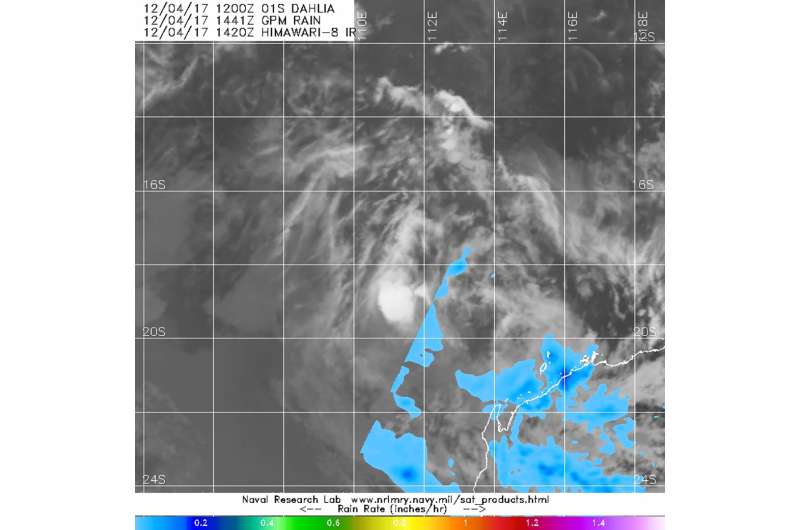NASA finds Tropical Depression Dahlia's center devoid of rainfall

Tropical Depression Dahlia was weakening into a remnant low pressure area when the Global Precipitation Measurement mission core satellite or GPM analyzed the storm's precipitation. GPM found the center devoid of rainfall and light rainfall to the east of center.
On Dec. 3 at 4 p.m. EST (2100 UTC) the Joint Typhoon Warning Center issued the final bulletin on Dahlia. At that time, Dahlia was still a tropical storm with maximum sustained winds near 35 knots (40 mph). Dahlia was centered near 16.2 degrees south latitude and 111.9 degrees east longitude. That's about 402 nautical miles north-northwest of Learmonth, Australia. Dahlia was moving to the south at 10 knots (11.5 mph/18.5 kph).
At the time of the last bulletin, infrared satellite imagery showed that the strongest storms were beginning to decouple from the low level circulation center and moving off to the southeast. Early the next day, the storm had become a depression then weakened further to a remnant low pressure area.
On Dec. 4 at 1441 UTC (9:41 a.m. EST), the GPM core satellite passed over Dahlia in the Southern Indian Ocean. Data collected by GPM's Microwave Imager (GMI) and Dual-Frequency Precipitation Radar (DPR) instruments were used to show the intensity of precipitation. GPM's radar (DPR ku Band) measured rain falling at 0.1 inches (2.5 mm) per hour to the east of the center of circulation near the coast of Western Australia. The center of circulation had no measureable rainfall.
The Australian Bureau of Meteorology issued Wind Warnings from 10:00 p.m. WST (local time, Western Australia) on Dec. 4, for the period until midnight WST Dec. 5, 2017. A Strong Wind Warning for the following areas: Perth Local Waters, Gascoyne Coast, Geraldton Coast, Perth Coast and Bunbury Geographe Coast
Dahlia was moving into cooler sea surface temperatures and an area of stronger wind shear, both factors that were expected to lead to its dissipation later on Dec. 4.
Provided by NASA's Goddard Space Flight Center




















